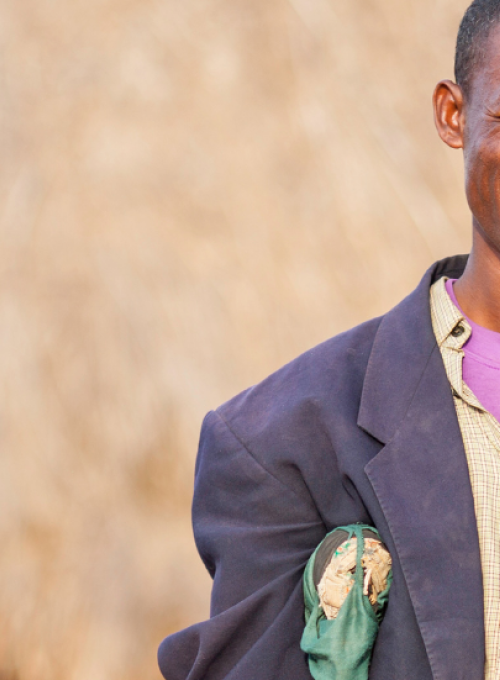
Uganda
According to available data, 6.8 million people, or one in six Ugandans, have a health condition that could benefit from rehabilitation. Approximately 25.5 percent of the population (12.4 million Ugandans) need one or more assistive products to support their functioning; yet, only 4.5 percent have access to the assistive products they need.
The Government of Uganda has taken important steps to improve the accessibility and availability of rehabilitation and assistive technology (AT) services. It is working to implement World Health Organization (WHO) recommendations for establishing rehabilitation and AT as important components of quality health services within the framework of universal health coverage, including increasing the number of rehabilitation professionals at the national, regional, and district levels.
ReLAB-HS worked with national and local stakeholders to transform the health system in Uganda to integrate rehabilitation and AT services, adapt to new challenges, share learnings, and support scale-up. ReLAB-HS focused efforts on service delivery improvement in the districts of Gulu and Lira in Northern Uganda, and in the districts of Iganga and Mayuge in Eastern Uganda.
In Uganda, ReLAB-HS established four “Networks of Care”—district-level “networks” of public and private health care entities that are connected to support the integration of rehabilitation services within primary care and improve the coordination of care between different levels of the health system.
General Overview
In close partnership with the Ministry of Health, WHO, academic and training institutions, professional associations, district health offices, rehabilitation professionals, primary care providers, and community health workers, ReLAB-HS worked to achieve the following:
Improved Delivery and Demand of Quality Rehabilitation and AT Services at the Community Level
- In collaboration with Makerere University, generated evidence on the feasibility of integrating rehabilitation at the community and primary care levels
- Co-designed rehabilitation and AT service delivery model and referral processes
- Supported stakeholders to identify and establish priority areas and action plans working toward integration and improving quality of care
- Supported district health offices and partners to form local Technical Working Groups to promote local ownership of integrating rehabilitation into existing district structures
- Supported the establishment of an AT “hub” to store, manage, and distribute assistive products, enabling the provision of simple assistive products at the primary care level
Developed Capacity of Health System Leaders, Managers, and Providers to Deliver Rehabilitation and AT
- Oriented community health extension workers and village health teams on early identification and referral for rehabilitation and AT
- Trained primary care providers on delivering basic rehabilitation and AT services
- Trained district office representatives and local assistive product technicians on AT-specific standard operating procedures
- Worked with academic institutions to strengthen the rehabilitation academic curriculum
- Strengthened leadership capacity of stakeholders across the system through the Global Rehabilitation Leadership Institute
Supported the Development and Implementation of Plans and Policies for Rehabilitation and AT
- In collaboration with the WHO and Ministry of Health:
- Completed the Systematic Assessment of Rehabilitation Situation (STARS) and the rapid Assistive Technology Assessment (rATA)
- Integrated rehabilitation and AT indicators into the health management information system
- Developed the National Rehabilitation and AT Strategic Plan
- In collaboration with Makerere University, generated evidence on how prioritization of rehabilitation can be strengthened within the policy environment
- Worked with rehabilitation professional associations to strengthen professional regulation for rehabilitation professions
General Activities
National Level
- Provided technical assistance for implementation of the National Rehabilitation and AT Strategic Plan
- Contributed to the development of the Priority Assistive Products List (APL) in collaboration with the WHO
- Continued to work with rehabilitation professional associations and academic institutions to strengthen workforce development
- Continued collaborating with local rehabilitation and AT leaders to foster a cohort of champions
District Level
- Worked with districts to:
- Improved integration of rehabilitation and AT services
- Strengthened workforce capacity
- Improved the assistive products supply chain and standard operating procedures
- Deployed a telerehabilitation mobile application to support continuity of care
Achievements
As a result of ReLAB-HS’s contributions to date:
- Over 10,900 more people have improved access to rehabilitation and AT services.
- Over 7,380* trainings on rehabilitation and AT have been completed.
- 18 rehabilitation and AT quality and integration processes have been strengthened in four local networks.
- 8 organizations have adopted the International Rehabilitation Education and Training Toolkit.
- 136 organizations and institutions have been strengthened.
* Reflects the number of course completions, as trainees may have completed one or more courses.
